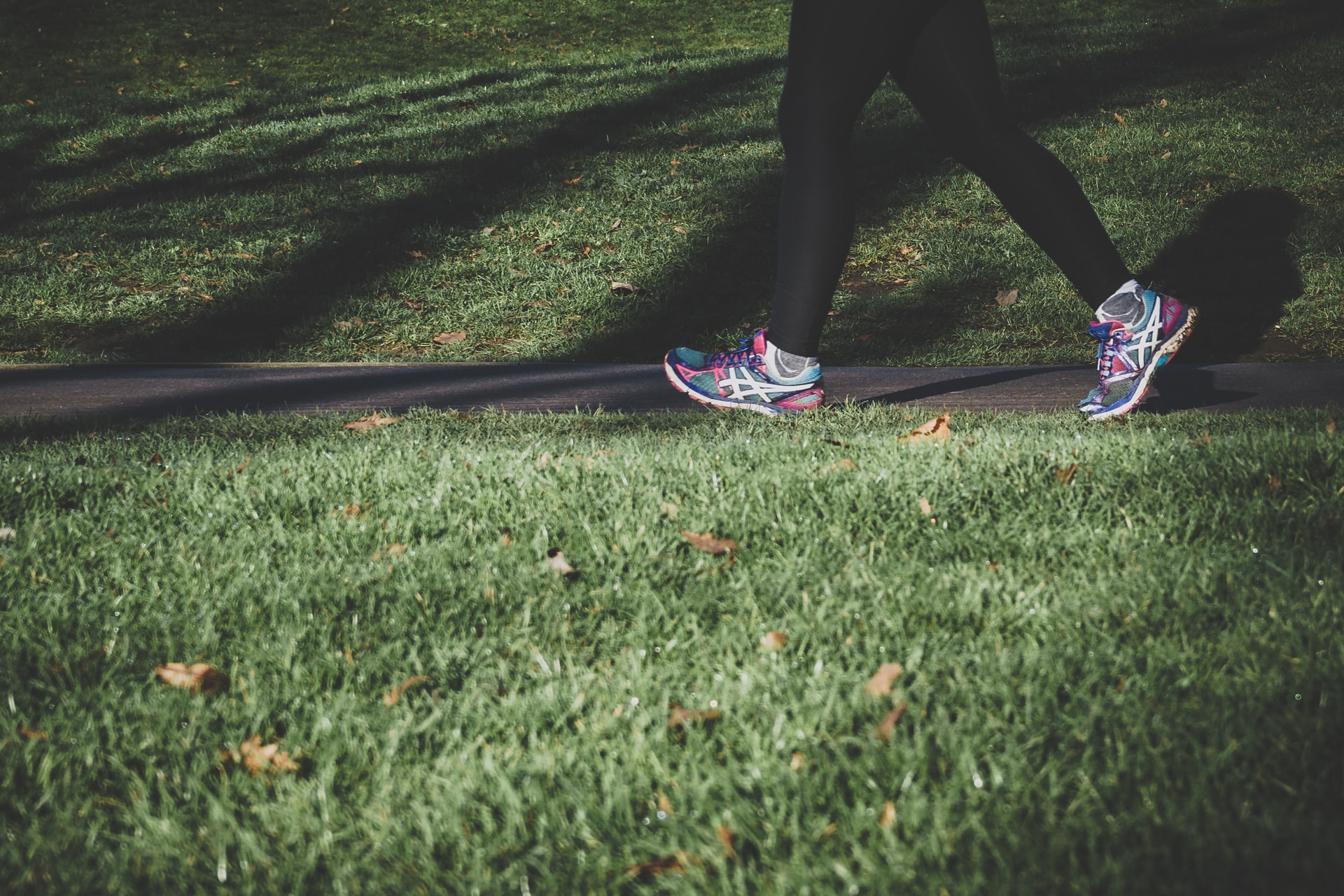Walking – it is one of those things you have been doing for years and take for granted. But do you know the five incredibly awesome ways walking improves your health?
Although you have been walking for years, did you ever think you may not be that great at it? If you suffer from back, knee, or hip pain, how you walk may be contributing to your discomfort.
So, take a walk on the wild side with me. I will show you how to make the simplest form of exercise one of the best ways to improve your health!
Maintaining a Healthy Weight
The Center for Disease Control recommends 150 minutes a week of moderately paced aerobic exercise a week for good health. So, if you take a 30-minute brisk walk five times a week, you have hit that goal.
The word ‘brisk’ is key here. A brisk walk should have you breathing a bit heavy. It means that you should feel your heart rate increase. You should also find it a bit difficult to talk and walk at the same time.
A brisk walk for most people means that you will cover about two or two and a half miles in half an hour.
Here is a tip. Drive your car around your neighborhood and map out a one-mile stretch. Walking out and back home in 30 minutes means that you are accomplishing a brisk walk.
If you can’t manage a thirty-minute walk each time, you can break it up into 15- minute segments throughout the day. Anything over 10 minutes at a time has health benefits.
Some people like to take a brisk walk before their morning shower. How about taking a walk during your lunch break? If you are looking for a way to socialize, phone a friend or two and meet up for a walk.
Would you like to lose a bit of weight? Combine your daily walk while monitoring your daily calorie intake. This can really help.
When you burn 3,500 more calories than you consume, you can lose between 1/2 to 1 pound. A brisk 30-minute walk 5-6 days a week can burn off 250 to 500 a day.
Here is an example. Kathleen eats about 1,500 calories a day or 10,500 calories per week. Her brisk half-hour walk burns at least 250 calories per day (but probably more). If she walks 6 days a week, she will lose at least ½ a pound a week.
Strengthening Bones and Muscles
Weight-bearing exercises help to build your bones and muscles. So, great news! Walking is a weight-bearing exercise. What does all this mean for us?
In a review of 18 studies about exercise and osteoporosis in postmenopausal women, the Cochrane Collaboration found that walking improves bone density in the spine and hips.
Post-menopausal women may lose bone and muscle mass by at least 2-3 percent every 5 years. As bone mass decreases, we increase our risk of developing osteoporosis, which causes thinning and weakening of the bones. Then we become more susceptible to fractures, especially in the hip, spine, and wrist.
Maintaining strong bones and muscles allow us to have an active and enjoyable lifestyle as we age. Do you know someone who is still dancing, skating, skiing, and even water skiing in their maturing years? They may have adequate bone density and strong muscles.
If you are really serious about building bones and preventing the increased risk of osteoporosis and bone fractures, check out my blog post on the best supplements for women over 50.
Managing Various Diseases
Physical activity can lower your risk for chronic diseases such as type-2 diabetes, heart disease, high blood pressure, stroke, some types of cancer, and depression. Let’s take a closer look.
Walking lowers blood glucose and insulin resistance. Walking also helps with weight loss and weight management – factors in controlling diabetes. So, if you suffer from type-2 diabetes, you may want to put those walking shoes on today.
Heart disease is the leading cause of death in the United States. The American Heart Association (AHA) promotes walking to decrease the risk of heart disease. The AHA recommends 30 minutes of physical activity per day and at least 150 minutes of moderate exercise per week.
Cancer is the second leading cause of death in the United States. The American Cancer Society recommends that you get at least a brisk walk for 150 minutes a week. Do you see a theme here?
Do you suffer from the pain and fatigue associated with various forms of arthritis? The Center for Disease Control and Prevention recommends ‘walking to improve arthritis pain, fatigue, function, and quality of life.’
Mayo Clinic research suggests that regular exercise such as walking may release ‘feel-good’ brain chemicals such as endorphins that may help with depression.
Suppose you or someone you love has been touched by any one of these diseases. In that case, you may want to seriously consider walking as your ‘go-to’ form of exercise.
Improving Your Mental Health
Walking can work wonders for your overall mental health. Aside from improving your self-esteem and mood, it can reduce stress, anxiety, and fatigue. Most importantly for women over 50 who may struggle, it can improve the quality of your sleep.
Physically active people have up to a 30% reduced risk of becoming depressed. Being active helps those who are depressed recover.
Meet Angela – a woman who has suffered from depression and anxiety for years. This is what she has to say about walking:
“The Covid-19 pandemic has me working from home now. I really miss my work friends and find myself feeling down and lonely. When those feelings start to surface, I know it’s time for me to get outside for a walk. Now I manage to feel much happier. I owe a lot of it to walking”.
Improving Balance and Coordination
Our sense of balance and coordination diminishes as we age. Medications, poor vision, loss of flexibility, and certain medical conditions are just a few reasons why this occurs. Loss of balance and coordination can increase our risk of falls and injury.
Walking can improve our lower body strength. This results in better balance and coordination.
The Importance of Having the Proper Walking Technique
Most of us walk without thinking about it. But just like weight training, the proper form makes a big difference.
Posture, stride, weight placement, and arm motion play a role in safety, physical benefit, and overall walking enjoyment.
Like driving a car, there are steps you need to take to do it properly. But these steps are not complicated, and they are well worth learning.
Here are the 7 steps to help you develop proper walking form. Make sure you check your form before you take your first stride. Each time you stop to take a break, recheck it:
- Stand up tall and straight. Make sure you do not arch your back.
- Do not lean forward or back unless you are on a hill. It puts a strain on your back muscles as you walk.
- Keep your eyes looking forward. Avoid looking down. Focus your eyes about 20 feet ahead of you. This helps you to see your path and anything coming at you from the sides.
- Keep your chin parallel to the ground. You will minimize strain on your neck and back.
- Relax your shoulders. Shrug once and allow your shoulders to fall and relax. Loose shoulders will relieve tension and help with good arm motion. Check your shoulders during your walk to help you stay relaxed.
- Engage your stomach muscles. Pretend you are trying to get your belly button to touch your spine. Your core muscles can help you maintain good posture and resist slouching and leaning.
- Tuck in your bottom. This will help prevent your back from arching.
If you are a visual learner, here is a short video that will help you improve your walking technique. It’s also a great video to help you learn how to move your arms and place your feet.
Gearing Up for Success
Wearing the best gear for comfort and ease when you walk is essential. Yes, you can look fashionable and still be comfortable. Better yet, you may already have everything you need.
If you need to pick up a few items, it can be well worth the minor expense. Think about purchasing items that wick sweat away from your body.
Here are some other things to consider:
- Make sure your socks fit well. They should not be too loose or too tight. Poor-fitting socks can cause blisters. You may be tempted to wear cotton socks. But cotton holds in moisture and can contribute to those blisters. Some socks will indicate that they help to wick moisture away.
- Choose comfortable pants. Leggings or a yoga pant with an elastic waistband is a great choice. If your budget allows, choose something in sweat-wicking fabric.
- Wear a hat that covers the top of your head, a pair of sunglasses, and sunscreen. These three items will keep you comfortable and contribute to good health.
- In hot weather, you may be tempted to wear something sleeveless. But try to wear something that gives you some cover. You would hate to put all this effort into your health but increase your risk of skin cancer.
- Depending on the weather, layering your clothes can be beneficial. For example, if you walk in the early morning, you may need some warmth. Layering will allow you to peel off a layer or two as you heat up.
- Carry water with you. Many stores sell containers with a carabiner clip so you can find a place to store it on your pants or jacket.
- If you only invest in one thing, make if your shoe. What you put on your feet will make or break your entire walking experience. Your fitness walking shoe needs to be flexible and provide support. It is best to ask for assistance at a sports shoe store.
Wearing the right stuff will increase your chances of walking longer and having more fun.
Conclusion
Walking is a fantastic way to improve your health. It helps you maintain healthy body weight and decreases depression, diabetes, some cancers, and heart disease. Walking even improves bone and muscle density.
Walking is an activity that you can do any time of day, does not require major equipment and its FREE!
With the right walking technique, you can easily make walking one of the best and easiest ways to keep yourself healthy and happy.
So why not put your walking gear on and give a 30-minute walk a try today! Let me know how long you walked and how you felt when you got home! I would love to hear from you on my Fit, 50, and Fabulous Facebook page.

